Executive Function
WHAT?
So what? You know the importance of the executive function, but what are some specific activities that you can implement in your classroom? Here are some ideas to help you “fuse” EF research in meaningful and practical ways.
Cheers and Goals 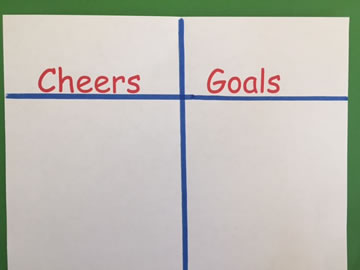
At the beginning of each month have students fold a sheet of paper in half. On the left side write “Cheers” and encourage them to write or draw pictures of accomplishments that they are proud of. On the right side right “Goals” and have them write/draw two or three goals that they have for the coming month. Date, save, and review at the end of each month. Encourage students to reevaluate goals and set new ones.
Hint! You could also share these with parents at conference time.
Paper Airplanes
Ask children to write and illustrate goals on a piece of paper. Next, demonstrate how to fold the paper into an airplane. Let students fly their airplanes across the room or on the playground as they visualize themselves achieving their goals.
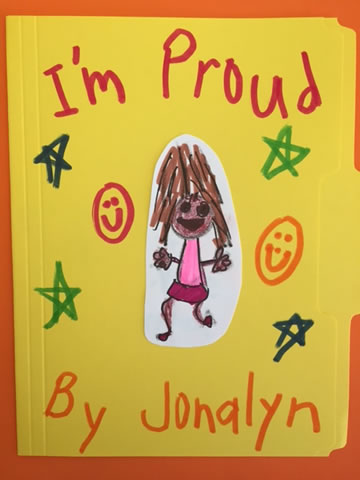
Pride Portfolio
Invite each child to decorate a file folder and store in a special box or tub in the classroom. When they do something they are proud of they can date it and store it in their folder.
•Hint! If you did this with an illustration and writing sample at the beginning of each month they could “revisit” past work and see how they are improving.
Car Wash
End the day in a positive way with the car wash. Students form two lines facing each other to make the “car wash.” Students hold up palms and circle them around. One child at a time walks through the car wash as friends gently touch them and say something positive.
Pat on the Back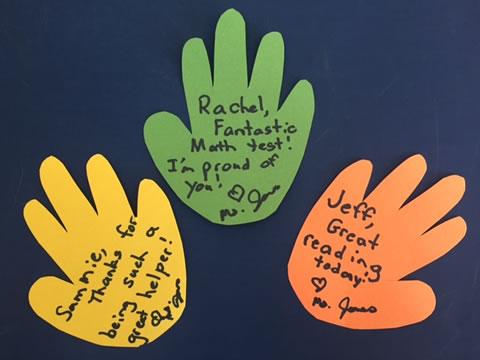
Students raise their right hand, stretch it across their body, and pat their left shoulder as they say, “Good job! Good job!”
•Cut hands out of construction paper. Write positive comments for students and tape them on their backs.
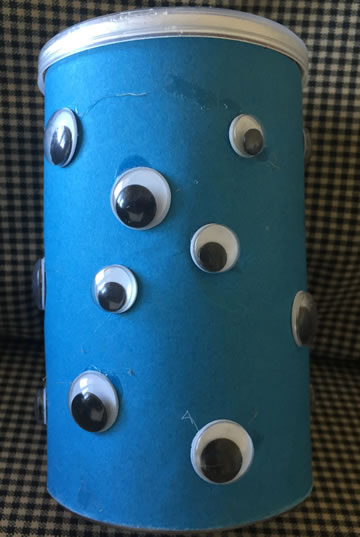
Eye Can
Cover a small can with construction paper. Cut pictures of eyes out of magazines and glue them on the can. Explain the importance of saying, “I can!” and “I’ll try!” Pass out the “eye can” to encourage students.
•Sing this song to the tune of “If You’re Happy and You Know It.”
I think I can are words I like to say.
I think I can are words I like to say.
In time I’ll get it right if I try with all my
might.
I think I can are words I like to say.
Gift Cards
Instead of giving out tangible rewards, create gift 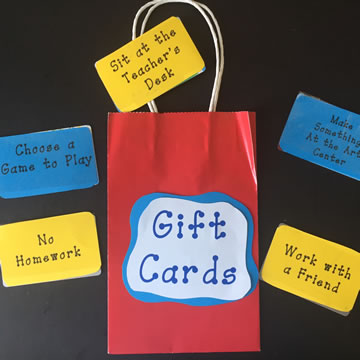 cards with special “treats”, such as those listed below. Write the activities on 2” x 3” rectangles and tape to used gift cards and hotel room key cards. Place in a gift bag and “invite” a child to choose a gift card for a job well done.
cards with special “treats”, such as those listed below. Write the activities on 2” x 3” rectangles and tape to used gift cards and hotel room key cards. Place in a gift bag and “invite” a child to choose a gift card for a job well done.
Be excused from a homework assignment.
Choose an indoor game to play.
Select the book for story time.
Sit by a favorite person all day.
15 minutes of free time.
Help the teacher do a special job.
Sit at the teacher’s desk.
Take off your shoes.
Listen to an IPod or headset while you work.
Take a class game or book home for the night.
Eat lunch with your teacher or a special friend.
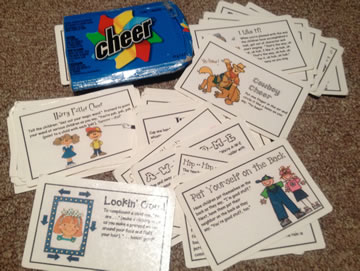
Give a Cheer
Use cheers to encourage the class and help them stay on task.
•Store cheer cards in a Cheerios box and let a student pull one out and lead the class.
Go here to download cheer cards.
Social Play
Vygotsky maintained that dramatic play is where children learn to regulate themselves. They take on imaginary roles and must stick to their roles and adjust to changing plots.
Note! It’s rather frustrating that every expert on EF emphasizes the importance of play, while increasingly play is disappearing from our classrooms and children’s lives!!!
Sing and Dance
Music is the perfect opportunity for students to learn to follow directions and develop self-regulation.
Patty Cake
When children patty cake with a friend they are learning to self-regulate, cooperate, develop spatial awareness, and activate both sides of the brain.
•Patty cake as you skip count. (Clap and cross tap as you count by 1’s, 2’s, 5’s, 10’s, etc.)
•Patty cake as you spell words. (Clap hands as you say a word. Cross and tap as you say each letter. High five hands in the air and repeat the word.)
•Patty cake as you say the alphabet and make the sound. (Clap and tap right hands as you say the letter. Clap and they tap left hands as you make the sound.)
Poetry
Asking students to memorize poetry can help improve short-term memory. Students need this “working memory” to organize information and complete tasks.
Dramatization
Let students dramatize events in history, books, songs, poetry, etc. They can even dramatize vocabulary words and sight words.
Physical Activity
Physical activity is not only important for brain function, but it also releases energy that will enable students to focus better.
Multi-sensory
Keep students engaged by activating all senses. Sign language, hands-on materials, motor activities, and music provide many pathways to the brain.


 cards with special “treats”, such as those listed below. Write the activities on 2” x 3” rectangles and tape to used gift cards and hotel room key cards. Place in a gift bag and “invite” a child to choose a gift card for a job well done.
cards with special “treats”, such as those listed below. Write the activities on 2” x 3” rectangles and tape to used gift cards and hotel room key cards. Place in a gift bag and “invite” a child to choose a gift card for a job well done.

